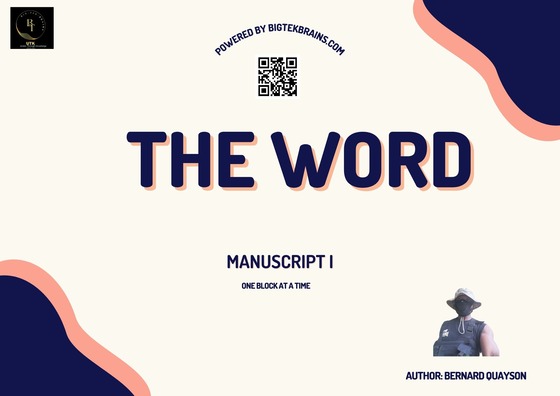AUTHOR: BERNARD QUAYSON

POINT TO PONDER
(John 1:1) - “In the beginning was the Word, and the Word was with God, and the Word was God.”
INTRODUCTION
“A word to a wise person” is indeed enough, as it created everything, including this physical planet (Earth). It’s translated in Greek as “logos“; which means an ‘expression of idea‘.
To communicate an idea, we use words. So, words can be referred to as an idea container or exposed thought.
WHAT TRULY IS THE WORD AND WHY IS IT SIGNIFICANT?
“In the beginning,” they say, “was the word,” and humanity’s quest for this fundamental expression of thought (precept-the thought before the thought) gave rise to religion and various misconceptions. The reason is that at some point in life, data keeping became challenging, and the human family could hardly process facts, figures, and symbols (data) to effectively communicate. This persisted until the emergence of the Sumerians, humanity’s first great civilization.
Since then, the interpretation of data (information) has become beneficial to users.
However, it is important to recognize that “information does not guarantee knowledge.” It needs to be organized and processed to effectively communicate understanding, experiences, accumulated learning, and expertise, particularly in relation to contemporary problems or processes. In that regard, it is emphasized biblically that only true knowledge of the word can set us free.
The inability of the early human family to understand the word has created a dangerous belief system of religion and countless erroneous ideas (misconceptions) that have led to all the problems of the world, including the massacre of thousands by the Crusaders (Western European Christians) aimed to conquer Jerusalem (the holy land in the Middle East), stopping Muslim rule (expansion) and reclaiming territory for Christianity during the period between 1095 and 1291.
UNDERSTANDING THE WORD
So, you see, it requires all levels of consciousness and specific types of human programming (such as moral and ethical codes) to understand the word.
The greatest threat to the future of the world is religion. In fact, nuclear weapons, terrorism, SARS, shifting governments, military coups, and AIDS are simply tools used by religion.
More wars have been fought in the name of religion than any other influence. India and Pakistan, formerly known as British India, now share a border after gaining independence from British rule in 1947. India claims Hinduism as its defining belief system, while Pakistan aligns itself with Islam. All the conflicts between religions come from competing searches.
It is not just the Buddhists, the Hindus, the Muslims, the
Christians, and other major or minor religions; even the
Agnostics and Atheists are part of the same search for the word.
The early civilization wasn’t early enough, so at a certain point in history, something went astray, leading to a misunderstanding of the word. To truly grasp something, one must be aware of its original intent. Understanding something requires knowledge of its original intent and design. It entails comprehending the purpose and principles by which it was intended to function.
PURPOSE AND PRINCIPLES
In reality, everything adheres to laws, and principles exist to simplify life. Note that the central principle of life is purpose and Purpose is inherent in everything that has been created. Knowing the purpose ushers understanding of the governing principles that guide its functioning. It is believed that the priority of every purpose has its origins in the Creator, and it has significant practical applications for us as human beings.
In order to truly comprehend the concept of “word,” it is imperative that we understand the purpose behind our existence on Earth. The pursuit of understanding life’s purpose stands as a fundamental challenge for humanity. Frequently, we find ourselves grappling with four (4) essential questions that are key to achieving success. Failure should not be regarded as a mere mistake; rather, it is an outcome, just as success is not merely a stroke of luck, but a deliberate result. It is for this reason that principles, or laws, are in place to guide the success of every creation. Take, for instance, the functioning of an airplane, which is made possible by adhering to the principles of lift and aerodynamics. Similarly, the establishment of Israel can be attributed to the adherence to the principles set forth by the law of Moses.
WHAT IS GOD'S BIG PICTURE?
Understanding is always in the mind of the creator. The most important thing to do when you want to understand the handy works of an artist is to try and get into his head. For artists, the notion of “finish” is ever-present in their minds. Therefore, it is crucial not to judge an artist while they are in the process of painting, as what you witness is merely the beginning stages of a finished idea. Similarly, religious history conveys the idea that God did not return to the earth to create another human being; rather, all of humanity originated from a single man. Consequently, the primary purpose of the male gender is fatherhood. Any other form of union that deviates from this purpose is as ancient as the cities of Sodom and Gomorrah.
CONCLUSION
Gaining a true understanding of something requires delving into the mind of its creator, to comprehend the intentions and design behind its functioning. This insight is often encapsulated within a concise book, serving as a manual accompanying the product. The manufacturer holds the key to understanding. Within that manual lies the law, safeguarding the product’s success. Thus, in the beginning, there existed the law, which resided with God, and through Moses, it was bestowed upon humanity, descending to Earth to save mankind from destruction. Success was intrinsically woven into every aspect, guided by fundamental principles.
